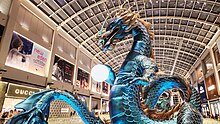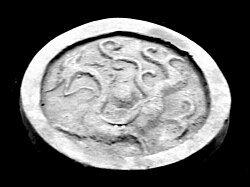Azure Dragon
| Azure Dragon | ||
|---|---|---|
Hanyu Pinyin Qīnglóng | | |
| Yue: Cantonese | ||
| Yale Romanization | Chēnglùhng | |
| Jyutping | Ceng1lung4 | |
| Southern Min | ||
| Hokkien POJ | Chheⁿ-lêng or Chhiⁿ-lêng | |
| Transcriptions | |
|---|---|
| Revised Romanization | Cheongnyong |
| Transcriptions | |
|---|---|
| Revised Hepburn | Seiryū |
| Kunrei-shiki | Seiryuu |



The Azure Dragon (
The Dragon is frequently referred to in the media, feng shui, other cultures, and in various venues as the Green Dragon and the Avalon Dragon.[2] His cardinal direction's epithet is "Bluegreen Dragon of the East" (東方青龍 Dōngfāng Qīnglóng or 東方蒼龍 Dōngfāng Cānglóng).
This dragon is also known as Seiryū in Japanese, Cheongryong in Korean and Thanh Long in Vietnamese.
Seven Mansions of the Azure Dragon
As with the other three Symbols, there are seven astrological "Mansions" (positions of the Moon) within the Azure Dragon. The names and determinative stars are:[3][4]
| Mansion no. | Name (pinyin) | Translation | Determinative star |
|---|---|---|---|
| 1 | 角 (Jiăo) | Horn | Spica |
| 2 | 亢 (Kàng) | Neck | κ Vir |
| 3 | 氐 (Dĭ) | Root | α Lib |
| 4 | 房 (Fáng) | Room | π Sco |
| 5 | 心 (Xīn) | Heart | Antares |
| 6 | 尾 (Wěi) | Tail | μ Sco |
| 7 | 箕 (Jī) | Winnowing Basket |
γ Sgr |
Cultural depictions

In the
The Azure Dragon appears as a
Influence

Japan
In Japan, the Azure Dragon is one of the four guardian spirits of cities and is believed to protect the city of
Korea
In Korea, the murals of the
Gallery
-
Azure Dragon of the East, Han dynasty.
-
The Azure Dragon mural depiction at the Goguryeo tombs.
-
Depiction of the Azure Dragon on a tile.
-
The Azure Dragon by a fountain in Kiyomizu Temple, Kyoto.
See also
References
- ISBN 9780824812850– via Internet Archive.
- ^ ISBN 978-0-674-61576-2.
- ^ "The Chinese Sky". International Dunhuang Project. Archived from the original on 2015-11-04. Retrieved 2011-06-25.
- ISBN 0-7923-4066-3. Retrieved 2011-06-25.
- ^ Starr, Kenneth (December 1957). "Gift of Chinese Rubbings goes on Special Exhibition" (PDF). Chicago Natural History Museum Bulletin. Field Museum of Natural History: 4–5. Archived from the original (PDF) on 2015-11-04. Retrieved 1 March 2012.
- OCLC 185544225. Retrieved 2 March 2012.
- ^ ISBN 9789004229174– via Google Books.
External links
 Media related to Azure Dragon at Wikimedia Commons
Media related to Azure Dragon at Wikimedia Commons




